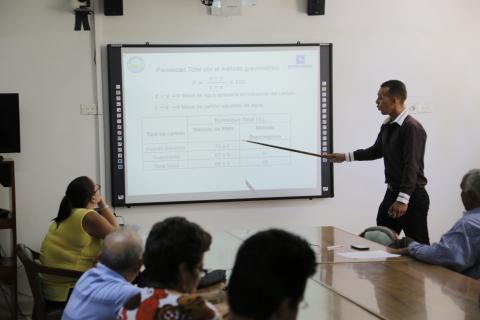
Faced with the challenge of increasing the energy efficiency of charcoal and extending the life span of activated charcoal in hemoperfusion cartridges, young Cuban engineers introduce the use of Nuclear Magnetic Resonance and X-rays aiming at reporting notable contributions in this field of the science.
In his Mechanical Engineering diploma thesis, Miguel Alejandro Rodríguez Domínguez determined the porosity profiles of several types of charcoals produced by slow pyrolysis, using the Nuclear Magnetic Resonance as technique. "It allowed me to calculate the porosity profile. To obtain it, I kept the coal in the oven at a single temperature. From now on, I will experiment with a variation of temperature in order to note what happens with the variation of the porosity and the stay of the raw material in the oven. "
Among the advantages of the use of Magnetic Resonance pointed out by this researcher, a novel technique in the definition of the porosity profile of the coal, is its non-destructive action, to be less expensive than others and to allow the study of a simple sample.
Charcoal results from distillation or incomplete combustion of firewood or other organic bodies. At present, it is one of the most important export fields in Cuba. Provinces such as Pinar del Río and Camagüey reach a production of more than 3 thousand tons of this product annually. How much does this experimentation contribute to increasing its efficiency?
"It is vital," says Rodríguez, "In the coalmines the phenomenon is the same: slow pyrolysis and porosity determine the quality of the coal, therefore, we are directly affecting the efficiency of that product".
On the other hand, Jean Michel Puentes Torres, a graduate of the Biomedical Major and current worker at the Centro Provincial de Electromedicina, is committed to extending the useful lifespan of activated carbon in hemoperfusion cartridges. "The fundamental idea is to attempt to regenerate that activated carbon and reuse it to use that cartridge in a combined treatment of hemodialysis, so that the time of use of the hemodialysis filter can be extended, which is quite expensive for the country."
Activated charcoal is an especially porous type of charcoal that has the ability to trap different compounds such as heavy metals, gases, toxins and waste products. It is also the main component in several products used to perform different detoxification processes.
According to Puentes, activated carbons used in hemoperfusion must have specific conditions to enter the bloodstream and avoid causing harm to the patient. "The idea of producing that coal was discarded and what we pretend is to exploit the activated carbon that the country imports and use it in combination with the dialysis filter".
The reuse of coal will be possible - explains Puentes - from the analysis of the degree of depletion of the activated carbon using X-ray and digital image processing, so that we have X-rays on a sample of coal and get an idea of how much substance is exhausted.
"I propose this technique because it uses the principle of absorption of matter on the X-rays to know what compounds are there, which is the principle of a digital radiography and this has not been reported at a global level yet ".
The need of this research is based on the fact that currently hemoperfusion treatments, indicated for severe intoxication, poisoning and other conditions are not performed in the territory due to the lack of hemoperfusion cartridges.
Both pieces of research will continue in the following years of the VLIR-UOS programme, as part of the studies on energy, biofuels and clean technologies for the sustainable development of eastern Cuba.
Jean Michel Puentes Torres explains that, when using X-rays on the activated carbon sample, the exhaustion level is obtained, which constitutes the first step for its reuse. Photos: Rovier Mesa
Translator: Lilia Sans

